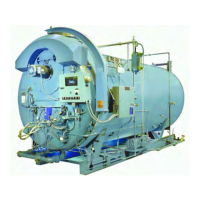Chapter 5 — Starting and Operating Instructions
Part No. 750-184 5-7
adjustable spring pressure. Since the air pump is not running at this
time, only tentative adjustment can be made. Without the air
supply, adjust the fuel oil pressure regulator so that the oil burner
gauge registers approximately 35 psi.
The pressure gauge will indicate a higher reading when the flame is
present and will increase as the firing rate increases. After the
burner is firing and when the air pump is running, final adjustment
can be made at the fuel oil controller.
Final regulation of oil flow to the nozzle can be done later, if
necessary, by adjusting the metering cam screws as outlined in
Chapter 6.
Starting - When all the conditions covered above and in Sections A,
B, C and D are assured, the burner is ready for firing.
F. FIRING PREPARATION FOR NO. 6 OIL (SERIES 400-
600)
Prior to initial firing, oil flow, pressure and temperature should be
established and verified. Atomizing air pressure should also be
established as outlined in Section D. Prior to firing, attach
combustion analysis instruments and monitor consistently
throughout the startup sequence. Refer to the adjustment
procedures in Chapter 6.
If the boiler is a combination fuel model, be certain that the main
gas shutoff cock is closed and set the gas/oil selector switch to “oil.”
Insert the burner drawer gun into its most forward position and latch
it in place.
Oil Flow - Open all valves in the oil suction and oil return lines.
Open the By-pass Valve on the fuel oil controller until oil flow is
established. Normally, the Orifice Valve is left in a closed position.
However, on cold starts, it may be opened for brief periods to aid in
establishing oil flow. The by-pass and orifice valves must be
returned to their closed positions as soon as oil flow is established
as indicated by a reading on the oil supply pressure gauge. Do not
attempt to set pressures while valves are open.
Momentarily energize the fuel oil pump starter to check for proper
pump rotation. With the rotation verified, prime the suction line
strainer with oil and turn the fuel oil pump switch to the "ON"
position. Check the oil supply pressure gauge for indication that oil
flow is established. If no pressure shows on the gauge after a few
moments, stop the oil pump and re-prime. Heavy oil in the storage
tank must be at a temperature to provide oil viscosity to permit flow
through the oil pump and suction line. If oil flow is not established
after several attempts, the conditions preventing oil flow must be
determined and corrected to avoid damage to the pump’s internal
mechanism.
A vacuum gauge should be installed in the oil suction line and its
reading observed and recorded for future guidance.
Oil Pressure - Oil pressure is regulated at several points. The first is
at the relief valve at the oil heater. The relief valve should be set so

